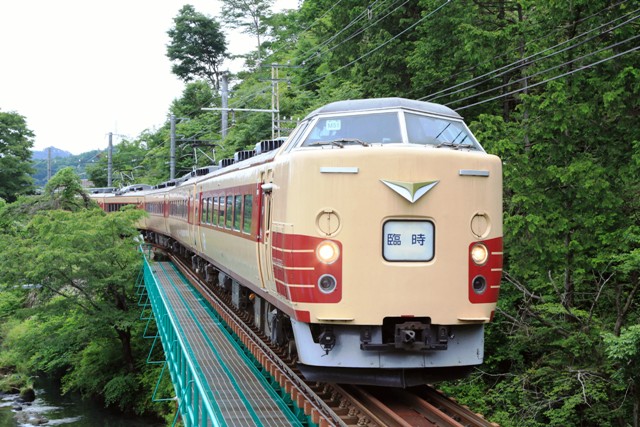Following the old streetcar exhibited in the Yokohama Tram Museum, I am going to continue to show you the other old pictures, which I rediscovered on my hard disk.
The EMU 183/189 series (the train set mixed by the 183 and 189 series) was a limited express train originally launched by the Japanese National Railways (JNR). The bodies of the 183/189 series was frequently called "the JNR color". Although JNR was abolished a long time ago, many rail-fans were boosterish about this coloring, because it fitted into any kind of scenery in Japan from urban business centers to mountain forests.
Technical specifications of the 183 and 189 series were almost the same. The only difference was that the 189 series had an additional system for operating on the Shin-etsu main line. It was a cooperative operation system with electric locomotives. This additional system was used for crossing the Usui mountain pass on the line. It was so steep that the 189 series was helped by the locomotive named Class EF63. After the inauguration of the Nagano Shinkansen (present the Hokuriku Shinkansen) in 1997, the track for crossing the Usui mountain pass was abolished. The 189 series became unnecessary, and was transferred to the other routes in the eastern part of Japan. They were then coupled with the existing 183 series, and became the 183/189 series.
The 183/189 series were retired from the tracks by March 28th, 2019 due to deterioration. It was the end of an era for the JNR colored trains.
The EMU 183/189 series (the train set mixed by the 183 and 189 series) was a limited express train originally launched by the Japanese National Railways (JNR). The bodies of the 183/189 series was frequently called "the JNR color". Although JNR was abolished a long time ago, many rail-fans were boosterish about this coloring, because it fitted into any kind of scenery in Japan from urban business centers to mountain forests.
Technical specifications of the 183 and 189 series were almost the same. The only difference was that the 189 series had an additional system for operating on the Shin-etsu main line. It was a cooperative operation system with electric locomotives. This additional system was used for crossing the Usui mountain pass on the line. It was so steep that the 189 series was helped by the locomotive named Class EF63. After the inauguration of the Nagano Shinkansen (present the Hokuriku Shinkansen) in 1997, the track for crossing the Usui mountain pass was abolished. The 189 series became unnecessary, and was transferred to the other routes in the eastern part of Japan. They were then coupled with the existing 183 series, and became the 183/189 series.
The 183/189 series were retired from the tracks by March 28th, 2019 due to deterioration. It was the end of an era for the JNR colored trains.















